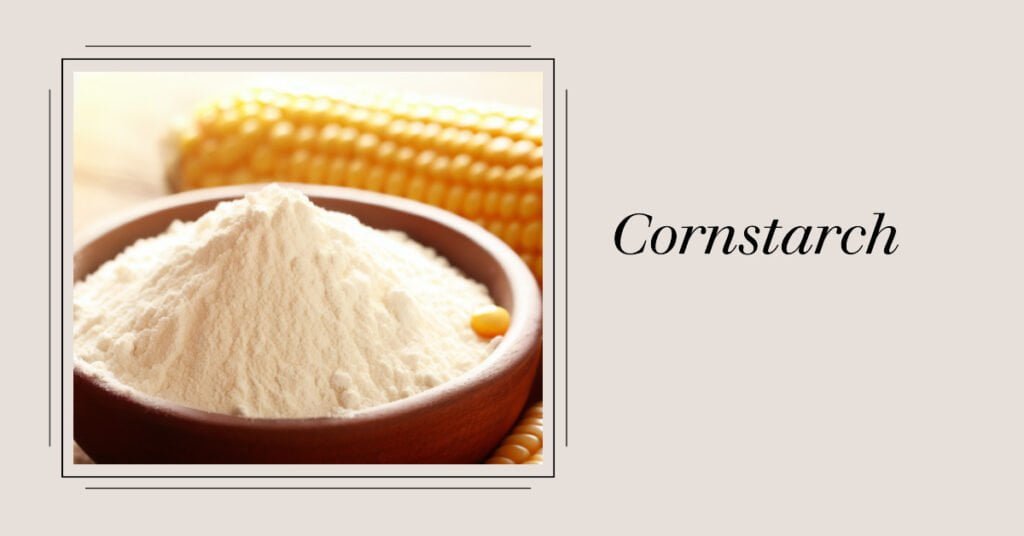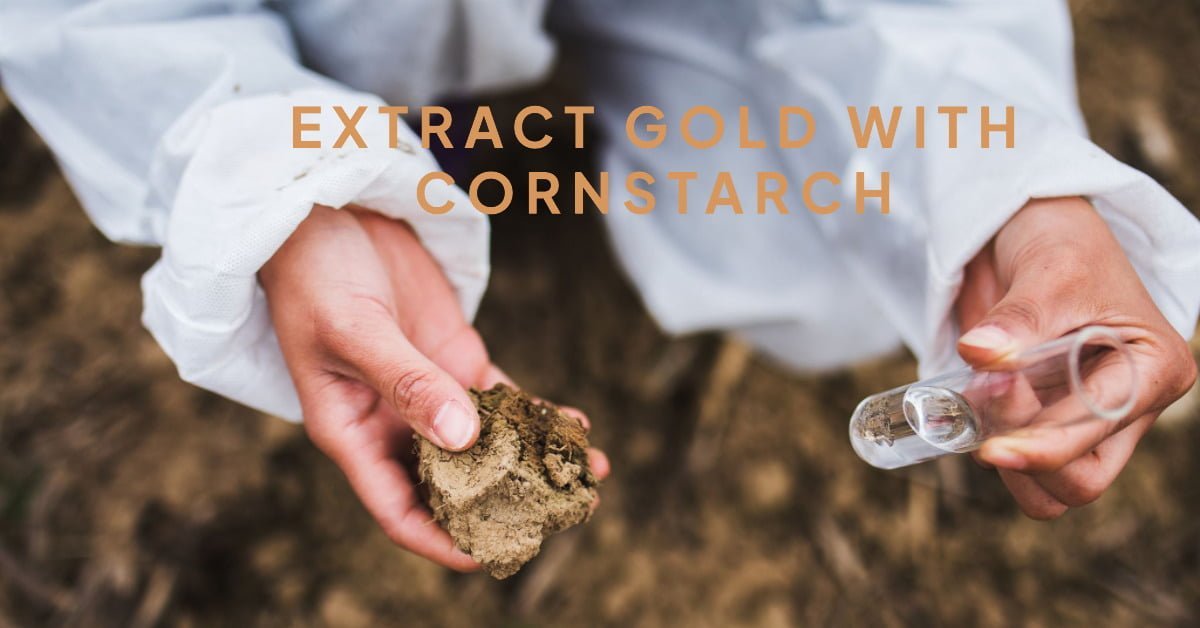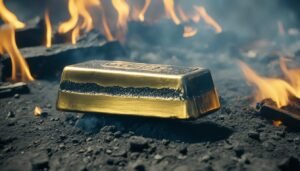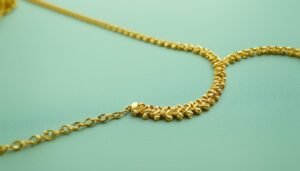If you’re looking for a cost-effective and eco-friendly way to extract gold, then using cornstarch may be the solution you need.
Conventional gold extraction techniques can be expensive and have a significant environmental impact.
Cornstarch is a natural alternative that can provide similar results while minimizing the negative effects on the environment.
Key Takeaways about How to Use Cornstarch to Extract Gold
1. Cornstarch can be used to extract gold
2. The process is simple and relatively safe
3. Cornstarch is an effective and environmentally friendly alternative to mercury
4. The process can be scaled up to industrial levels
5. Cornstarch is a renewable resource
Understanding the Science Behind Cornstarch Extraction
Using cornstarch to extract gold is a natural method that relies on the scientific process of sedimentation and filtration. In order to understand how this method works, it is important to first understand the properties of cornstarch and gold particles.

Cornstarch is a common household item that is often used as a thickening agent in cooking. It is made from the starchy part of corn kernels, which contains long chains of glucose molecules.
When mixed with water, cornstarch forms a slurry that has adhesive properties due to the hydrogen bonding between the glucose chains.
Gold particles, on the other hand, are small specks of gold that are found in rocks and ores. These particles have a positive charge and are attracted to surfaces that have a negative charge.
When cornstarch is mixed with water to form a slurry and added to a mixture of gold particles, the gold particles become embedded in the sticky slurry due to their attraction to the negative charge of the cornstarch. As the mixture is allowed to settle, the heavier gold particles sink to the bottom of the container along with the cornstarch slurry, separating them from the rest of the materials in the mixture.
The next step in the process involves filtering the gold particles from the cornstarch slurry. This is achieved through the use of a filter cloth, which separates the gold particles from the slurry and allows them to be collected for further processing.
Overall, the process of using cornstarch to extract gold relies on the adhesive properties of cornstarch to capture gold particles. The scientific process of sedimentation and filtration is used to separate the gold particles from the rest of the materials in the mixture, resulting in an eco-friendly and cost-effective method of gold extraction.
Preparing the Cornstarch Mixture
Once you have acquired your cornstarch, the next step is to prepare the slurry mixture that will be used to extract gold.
You will need to gather the following ingredients to prepare the cornstarch mixture:
| Ingredient | Amount |
|---|---|
| Cornstarch | 4 tablespoons |
| Water | 1 cup |
First, add the cornstarch to a mixing bowl.
Next, slowly pour in the water while continuously stirring the mixture. Stir until the mixture achieves a smooth and consistent texture.
Be careful not to add too much water, as this can make the mixture too thin and reduce its effectiveness in capturing the gold particles.
Once the mixture has reached the desired consistency, cover it with plastic wrap to prevent it from drying out before use.
Crushing and Grinding the Gold Ore
The first step in using cornstarch to extract gold is to crush and grind the gold ore to the desired particle size. This entails breaking the ore down into small pieces, which can then be easily processed. It is important to achieve the right particle size for optimal gold extraction.
The size of the gold ore particles will depend on the type of gold ore being mined. Different ores have different properties, and the particle size will vary depending on the specific ore. In general, the gold ore needs to be ground to a fine powder to maximize the surface area available for the cornstarch to bind to.
The process of crushing and grinding the gold ore can be done using a variety of equipment, including jaw crushers, gyratory crushers, cone crushers, and hammer mills. Once the desired particle size has been achieved, the gold ore is then ready to be mixed with the cornstarch slurry.
Particle Size
The optimal particle size for gold extraction using cornstarch is typically in the range of 75-100 microns. This particle size allows for maximum contact between the cornstarch and the gold particles, which enhances the adhesive properties and maximizes gold recovery.
| Gold Ore Type | Particle Size (microns) |
|---|---|
| Free-Milling Gold Ore | 75-100 |
| Refractory Gold Ore | 100-150 |
| Complex Gold Ore | 150-200 |
Mixing the Cornstarch Slurry with Gold Ore
Now that the cornstarch slurry is ready, the next step is to mix it with the gold ore. It is important to ensure that the gold ore is crushed and ground to the desired particle size before adding the cornstarch slurry.
Thorough mixing is crucial to achieving a proper reaction between the cornstarch and the gold particles. The mixture should be stirred vigorously and continuously to ensure that all the gold particles are evenly coated with the cornstarch slurry.
It is recommended to mix the cornstarch slurry and gold ore in a large container or basin. This will ensure that there is enough space to mix the materials effectively.
Once the mixing is complete, allow the mixture to sit for a few minutes. This allows the cornstarch to bind with the gold particles and prepare for the next step in the extraction process.
Allowing the Cornstarch to Settle
After mixing the cornstarch slurry with the gold ore, the next step is to allow the mixture to settle. During this period, gravity and sedimentation come into play, separating the gold from the cornstarch slurry. The settling period typically lasts for at least an hour, and sometimes up to several hours, depending on the size of the mixture and the amount of gold present.
It is essential to ensure that the container holding the mixture is kept still during the settling process to avoid any disruption or agitation. Any disturbance can cause the gold particles to remain suspended in the mixture, making it difficult to separate them from the cornstarch slurry.
Once the mixture has settled, the cornstarch slurry will be on top, while the heavier gold particles will have settled at the bottom of the container. The next step is to filter the mixture to separate the gold particles from the cornstarch slurry.
Filtering the Gold Particles
Once the cornstarch slurry has settled, the next step is to filter out the gold particles. This process separates the gold from the rest of the mixture, leaving behind a mixture of cornstarch and water.
One effective way to filter the gold particles involves using filter cloth. The filter cloth is placed over a funnel, and the mixture is poured through. As the liquid passes through the filter cloth, the gold particles are left behind, caught in the fibers of the cloth. It is important to ensure that the filter cloth is fine enough to effectively catch all the gold particles.
After filtering, the gold particles can be collected and rinsed thoroughly to remove any remaining cornstarch. This will result in extracted gold that is of a higher purity.
Drying and Collecting the Extracted Gold
Once the gold has been separated from the cornstarch slurry, it needs to be properly dried and collected for future use. This is a critical step in the process, as the purity of the collected gold can be affected if not properly handled.
To begin, spread the collected gold particles evenly on a clean, dry surface, such as a glass or ceramic plate. Allow the gold to air dry for a few hours or until there is no moisture left on the surface. It is important to avoid using any type of heat source for the drying process, as this can potentially damage the quality of the gold.
After the gold has dried, use a clean, dry brush or a soft cloth to carefully collect the particles and transfer them to a clean, dry container for storage. It is recommended to label the container with the date of extraction and the type of ore from which the gold was extracted.
It is important to note that the purity of the extracted gold can vary depending on the quality of the ore and the effectiveness of the cornstarch extraction process. To ensure the highest possible purity, it may be necessary to repeat the extraction process with the same ore.
Advantages of Cornstarch Extraction
Using cornstarch as a method for gold extraction offers numerous advantages over traditional techniques. Here are some of the most notable benefits:
| Advantage | Description |
|---|---|
| Cost-effective | Cornstarch is a readily available and affordable ingredient that is much cheaper compared to chemical alternatives such as cyanide. The process can also be performed in-house, reducing additional expenses for outsourcing or transportation. |
| Eco-friendly | Cornstarch is a 100% natural and non-toxic ingredient that poses no threat to the environment or human health. The process does not produce any hazardous waste or emissions, reducing the damage to local ecosystems and communities. |
| Efficient | The cornstarch extraction process is capable of extracting up to 90% of gold particles from ore samples, providing efficient recovery rates. |
| Selective | Cornstarch has adhesive properties that selectively bind to gold particles while leaving other materials in the ore sample unharmed. This selectivity reduces the amount of time and resources wasted on separating gold from other materials. |
| Safe and easy to use | Cornstarch extraction requires no complex equipment or machinery, making it a safe and user-friendly process that can be performed by anyone with basic knowledge and skills. |
Overall, the use of cornstarch for gold extraction presents a valuable alternative to traditional methods that are often harmful to both the environment and human health.
Disadvantages and Limitations
While cornstarch extraction for gold recovery offers numerous benefits such as being cost-effective and eco-friendly, it also has some distinct limitations and disadvantages that need to be considered.
One significant limitation of this extraction method is its effectiveness on an industrial-scale. At present, cornstarch extraction remains an experimental technique and hasn’t been widely adopted for large-scale gold recovery operations.
Another challenge associated with cornstarch extraction is its efficiency compared to conventional techniques. Although cornstarch has adhesive properties that can effectively capture and bind gold particles, it may not be as efficient as other extraction methods, particularly when working with low-grade ores.
Furthermore, the cornstarch extraction process may require more time and effort than traditional techniques, which could affect its adoption by commercial gold mining companies.
It’s also important to note that cornstarch extraction for gold recovery has some disadvantages. For instance, the purity of extracted gold may be lower compared to conventional techniques that use chemicals. Additionally, the process may not be suitable for all types of ores, which could limit its applicability.
Some other potential disadvantages and limitations of cornstarch extraction include:
- The need for specialized equipment for filtration and sedimentation.
- The requirement for a precise cornstarch mixture ratio to achieve optimal results.
- The potential for contamination from other minerals or substances present in the ore.
Despite these limitations and disadvantages, cornstarch extraction offers a promising alternative to traditional gold extraction methods. Scientists and researchers continue to investigate this approach, with the aim of improving its efficiency and applicability for commercial mining operations.
FAQs about How to Use Cornstarch to Extract Gold
Here are some commonly asked questions related to using cornstarch for gold extraction:
Resources and External Links
Here are some additional resources and external links that can help you understand more about “How to Use Cornstarch to Extract Gold”:
Articles:
- Extract Gold with Cornstarch – 911 Metallurgist
- Cornstarch Replaces Cyanide In Clean New Gold Extraction Method
- Extract gold with cornstarch | Ecological method – Afroculture.net
- Cornstarch May Provide Green Method to Extract Gold
YouTube Videos:
- Turning Mercury Into Gold! – PioneerPauly
- Non-Toxic Gold Extraction | Research at Curtin – Curtin University
- Simple gold recovery with salt and vinegar! – 999 Dusan
- A Safe, Cheap, & Efficient Way To Dissolve Gold Using A Little Known Compound – OzGeographics
- Crushing Rocks to Extract Gold – Vo-Gus Prospecting
These resources provide additional information and insights about “How to Use Cornstarch to Extract Gold”.








